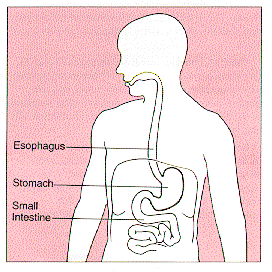Stomach
digestive organ From Wikipedia, the free encyclopedia
Remove ads
The stomach is part of the digestive system. It is an internal organ between the esophagus and the small intestines.
This relies largely or entirely on a single source. |


The stomach is the third stage in the digestive process. It holds food after eating. Food in the stomach then passes to the small intestine, where most of the food's nutrition is absorbed.
Other words for stomach include belly and tummy.
Remove ads
Function
In humans
The stomach contains hydrochloric acid of pepsin made by stomach cells. As a useful side-effect, the acid kills bacteria in the food. However, its main function is to help the protein-digesting enzymes called proteases work. In general, the food is churned, squeezed and mixed. This prepares it for digestion. The partially digested food is called chyme.
In other mammals
Stomachs of other mammals work differently to human stomachs. Ruminants, for example, have a stomach with multiple compartments. In that system, food goes through the first part of the digestive system twice, and the work of digesting the grass is done by bacteria.
Remove ads
Problems
Stomach acid can cause problems. It can make peptic ulcers worse. It can also cause heartburn: pain in the chest when acid from the stomach refluxes (backs up into) the oesophagus. These can usually be treated by neutralizing the acid.
Vomiting occurs when food goes back up the oesophagus and out the mouth. Vomiting can be a symptom of disease.
Related pages
References
Wikiwand - on
Seamless Wikipedia browsing. On steroids.
Remove ads
